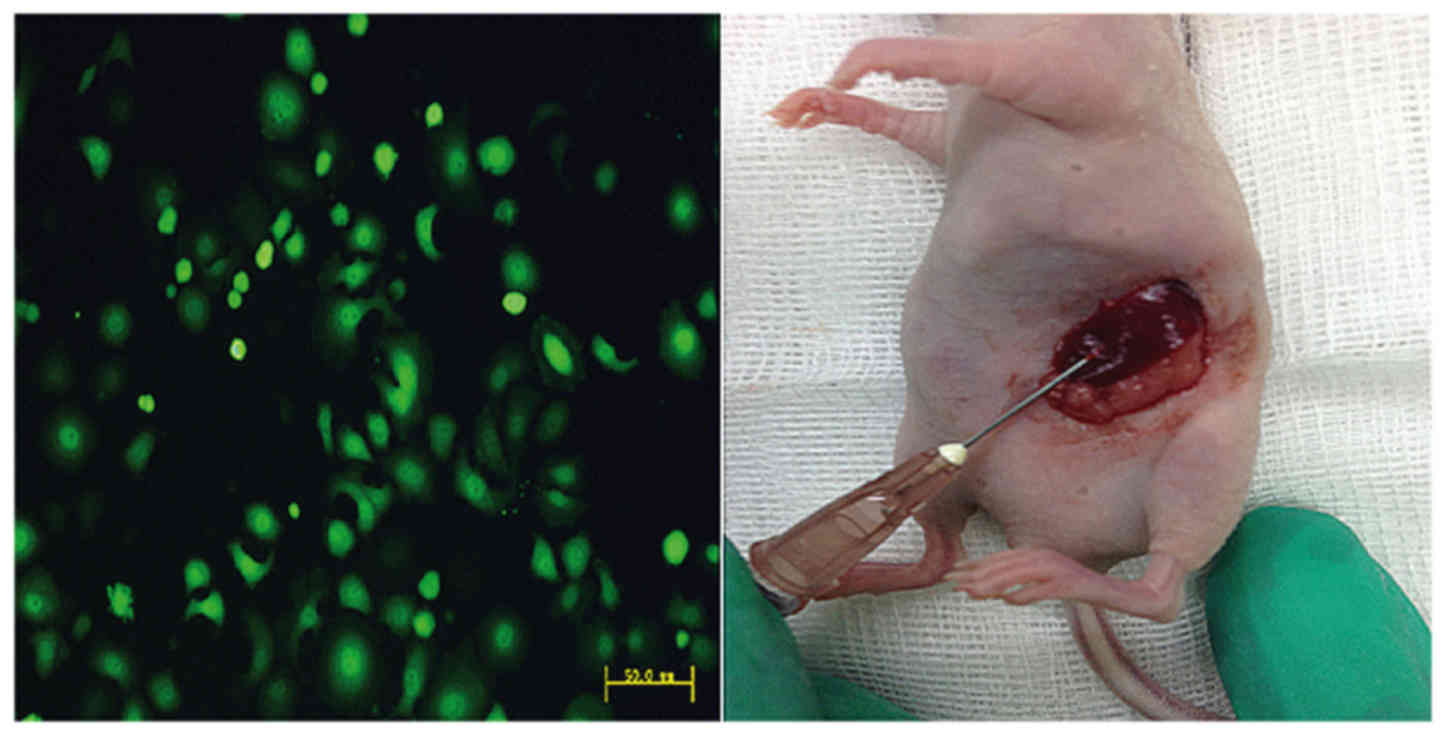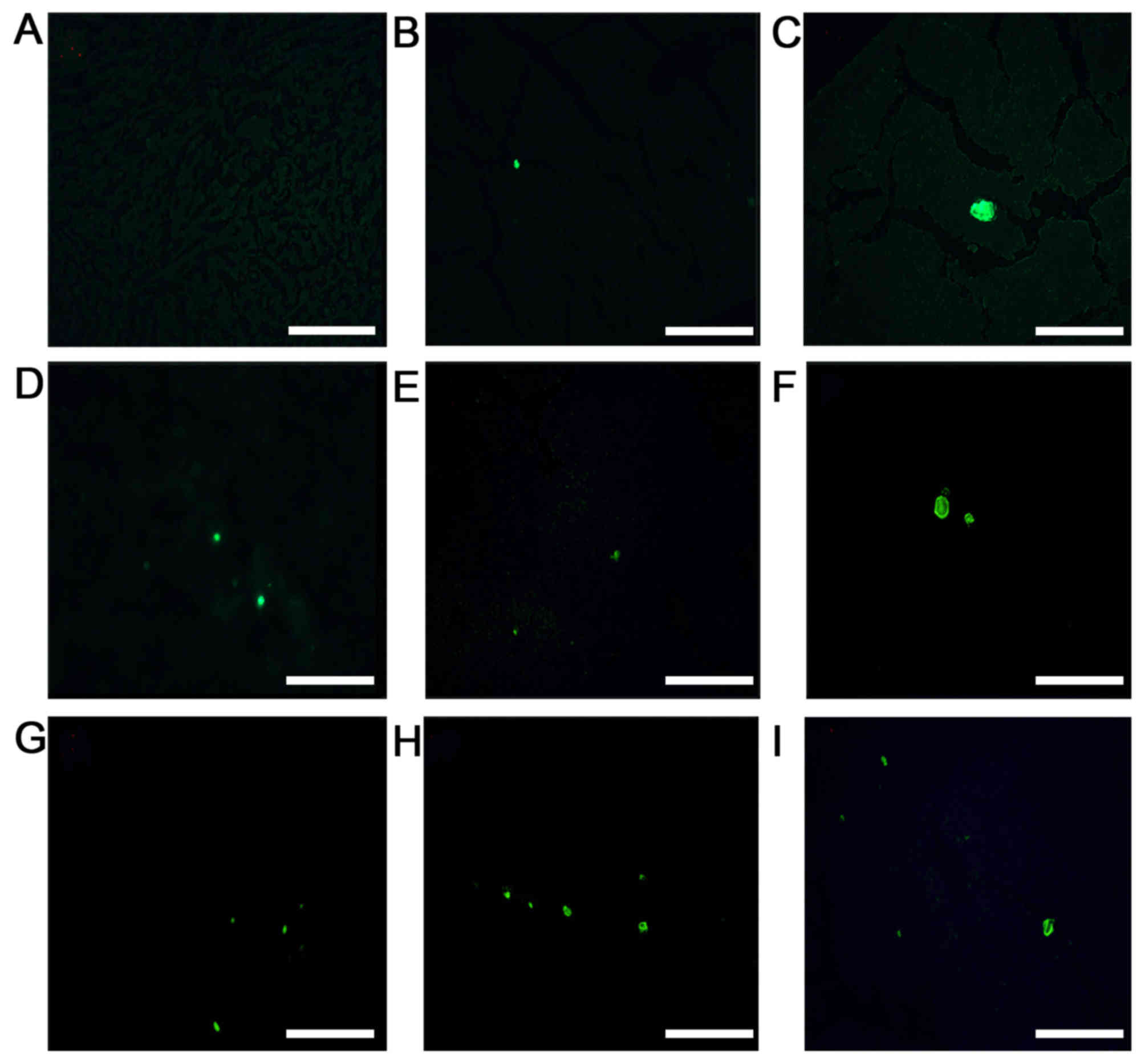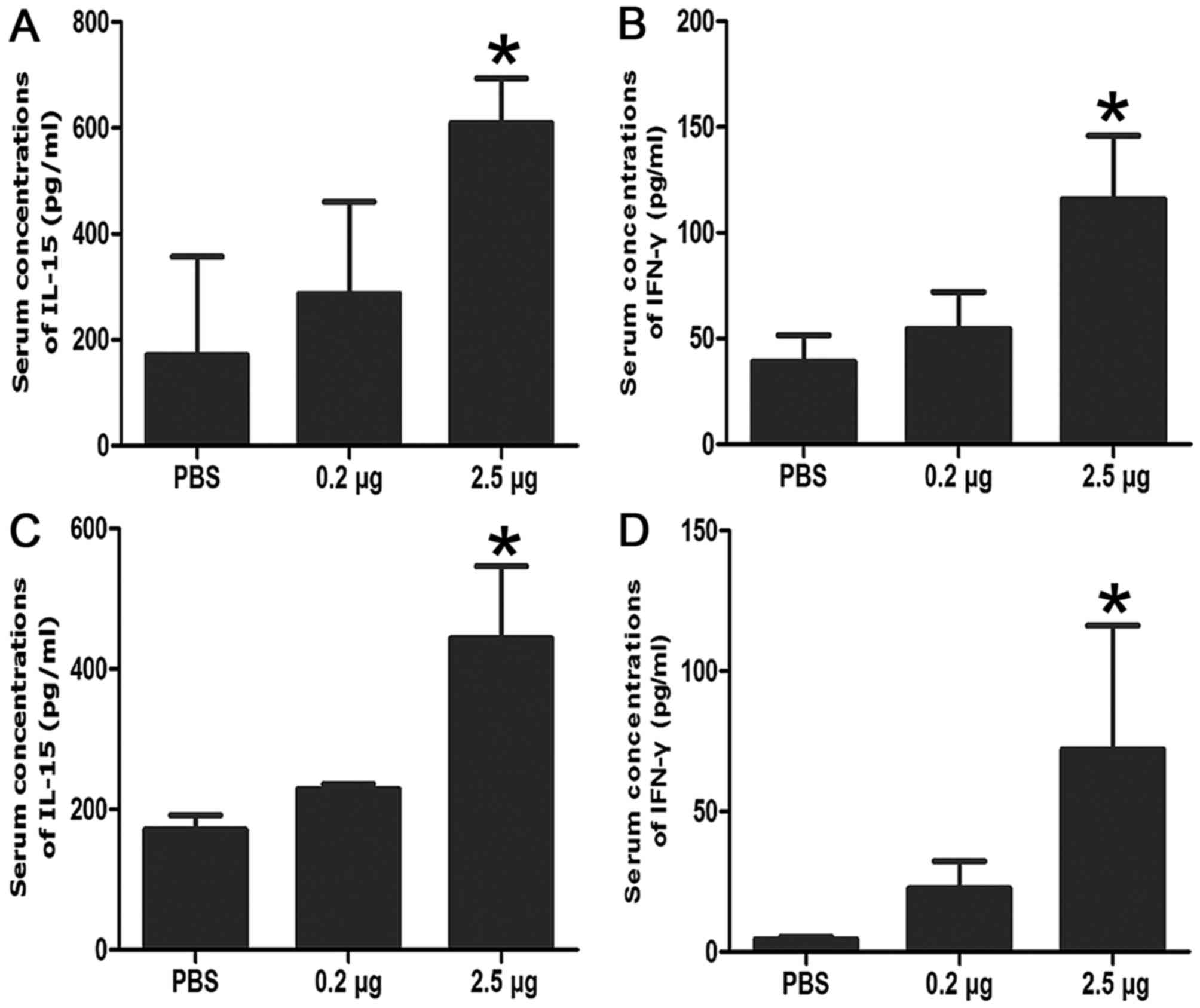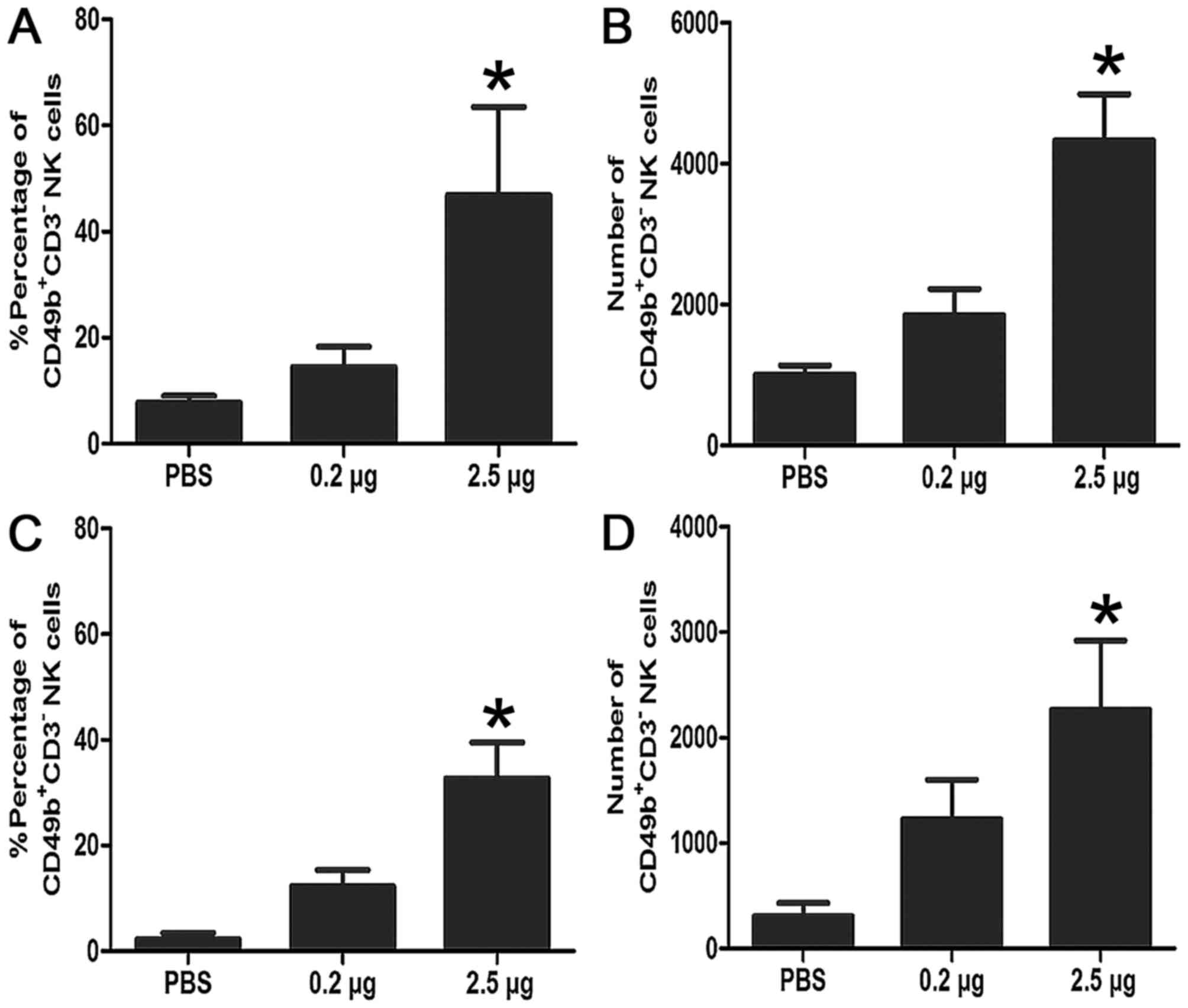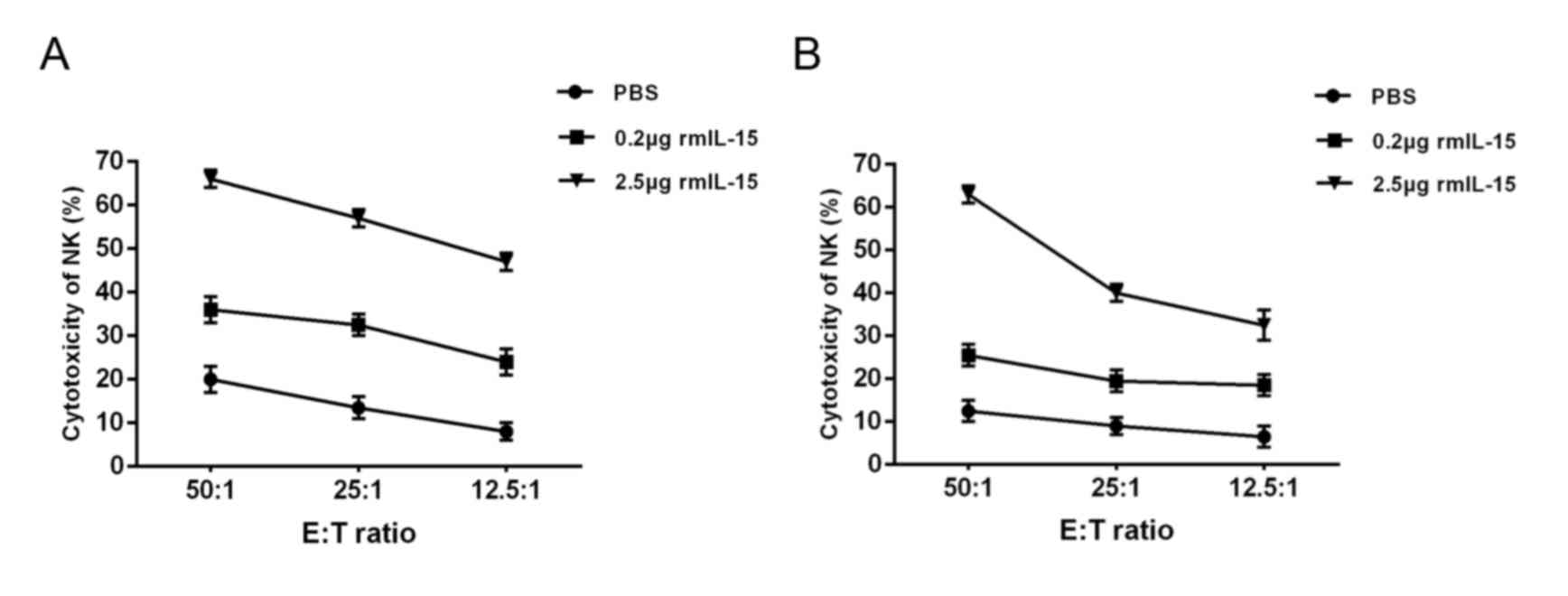Introduction
Gastric cancer is the fourth most common cause of
cancer-associated mortality worldwide (1). The major causes of mortality are due to
local recurrence and distant metastasis (2). Liver metastasis can be found in 5–9% of
patients with gastric cancer (3–5). Liver
metastasis from gastric cancer (LMGC) has a poor prognosis and
there are no effective treatment modalities (6). The present treatment of LMGC includes
surgical resection, radiofrequency ablation, hepatic arterial
infusion, systemic chemotherapy and targeted therapy (7). However, current treatments are
ineffective and the prognosis is poor. Therefore, studies on LMGC
remain an important issue.
Interleukin (IL)-15 was co-discovered by two
different studies in 1994 and characterized as a T cell growth
factor (8,9). Mature human IL-15 is a 14–15 kDa
glycoprotein and a member of the four α-helix bundle family of
cytokines (10). IL-15 binds to the
IL-15-specific high affinity binding protein IL-15Rα and signals
through a β chain and a γ chain signaling complex, leading to the
recruitment of Janus kinase (JAK) JAK1 by the β chain and
activation of JAK3 that is constitutively associated with the γ
chain (11). IL-15 performs important
roles in immune response, such as stimulating the proliferation of
activated T cells (9), B cells
(12) and NK cells (13), and shares two receptor subunits with
IL-2 (14,15). IL-15 has innate antitumor activity
independent of NK and CD8 T cells (16). The direct administration of IL-15 has
shown antitumor effects in several preclinical studies of IL-15
immunotherapy in murine tumor models (17,18). Thus
far, there have been seven clinical trials initiated to explore
anticancer vaccination or immunotherapy with IL-15 (19).
According to recent advances, IL-15 is a promising
cytokine for cancer immunotherapy, however the association between
IL-15 and LMGC remains unknown. Therefore, the present study used a
LMGC mouse model to investigate the role of IL-15 in liver
metastasis. Using different doses for treatment, the role of IL-15
in LMGC was investigated.
Materials and methods
Cell line
The gastric cancer MKN45 cell line and YAC-1, a
mouse lymphoma cell line sensitive to NK cells, were obtained from
Shanghai Institute for Biological Sciences, Chinese Academy of
Sciences (Shanghai, China). Cells were cultured at 37°C in a
humidified atmosphere containing 5% CO2, and maintained
in RPMI-1640 supplemented with 10% fetal calf serum, 100 U/ml
penicillin and 0.1 mg/ml streptomycin (all supplied by Invitrogen;
Thermo Fisher Scientific, Inc.). Stable green fluorescent protein
(GFP)-expressing MKN45 cells (MKN45-GFP) were maintained in the
same culture as the MKN45 cells.
Mice
Female BALB/c nu/nu mice (n=54) and BALB/c mice
(n=18), 4–6-week-old and 15–20 g, were purchased from Chinese
Academy of Sciences. All mice were maintained under specific
pathogen-free conditions in the Animal Facility of Fudan University
(Shanghai, China). Mice were fed a standard laboratory chow, given
water as required and subjected to an equal 12-h light/dark cycle
in accordance with institutional guidelines. These experiments were
approved by the Shanghai Medical Experimental Animal Care
Commission.
Liver metastasis model and treatment
procedure
A total of 1×106 (0.2 ml) MKN45-GFP cells
were re-suspended in sterile PBS and injected into the spleen
parenchyma of all mice following anesthesia using 1% pentobarbital
sodium (50 mg/kg). The spleen was removed 5 min following tumor
injection to prevent spleen tumor formation, so that metastatic
lesions developed only in the liver.
All BALB/c nu/nu mice (n=36) were randomly assigned
to receive the following treatments: Low dose group (n=12), 0.2 µg
rmIL-15 in 0.1 ml saline; high dose group (n=12), 2.5 µg rmIL-15 in
0.1 ml saline; control group (same volume of PBS, 0.1 ml, n=12).
All the mice were treated 5 times a week for 3 weeks. On day 28, 6
mice from each group were sacrificed, their livers were harvested,
the number of liver metastases nodules was counted and liver weight
was measured. The rest of the mice (3 groups, n=6/group) were
monitored for survival according to the different therapies (0.2 µg
rmIL-15, 2.5 µg rmIL-15 or PBS).
Assessment of liver tissue
The livers were excised and fixed with 10% buffered
formalin for 24 h at 4°C and were paraffin-embedded. Stable
GFP-expressing MKN45-GFP cells were injected into the spleen
parenchyma Tissues were cut into 5 µm thick serial sections for
fluorescent imaging. The number of liver metastatic nodules in each
tissue section were evaluated by fluorescence microscopy (Olympus
Corporation, Tokyo, Japan).
ELISA of cytokines
Blood samples (1 ml, n=6/group) were obtained from
the tail vein of mice on day 12. Blood was centrifuged at 1,000 × g
for 15 min at room temperature. Subsequently, the serum was
extracted and the extracted serum was stored at −80°C. The serum
IL-15 and interferon (IFN)-γ concentrations were measured by ELISA
with the use of Quantikine ELISA kits (R&D Systems, Inc.,
Minneapolis, MN, USA), and the ELISA was performed as indicated in
the manufacturer's protocol. Quantifications were conducted in
triplicate.
Flow cytometric analysis
Selective NK depletion was confirmed with a
FACSCalibur flow cytometer (BD Biosciences, Franklin Lakes, NJ,
USA) on day 21. Blocking was performed using FcR Blocking Reagent
mouse (Miltenyi Biotec GmbH, Bergisch Gladbach, Germany) at 4°C for
30 min. The mouse splenocytes were incubated with saturating
amounts (1 µg/106 cells) of phycoerythrin conjugated
anti-mouse cluster of differentiation (CD) 49b monoclonal antibody
(mAb; 1:100; cat. no., 553858; BD Biosciences) and fluorescein
isothiocyanate-conjugated anti-mouse CD3 mAb (1:100; cat. no.
555274; BD Biosciences) for 30 min at 4°C. Following incubation,
cells were washed once in PBS (400 × g for 15 min at 4°C) and
analyzed for fluorescence intensity using the FACS Calibur
cytometer Data were processed using FlowJo software version 7.6 (BD
Biosciences).
Cytotoxicity assay
Effector cells from each of the treatment groups
were cultured with 1×104 MKN45 target cells/well in
triplicate at varying effector to target cell ratios, and incubated
at 37°C for 4 h. Cytotoxic activity was measured by lactate
dehydrogenase release. The percentage cytotoxicity was calculated
as 100× [(experimental release)-(effector spontaneous
release)-(target spontaneous release)]/[(target maximum
release)-(target spontaneous release)].
Statistical analysis
All statistical analyses were performed with SPSS
19.0 for Windows (IBM Corp., Armonk, NY, USA). Data are presented
as the mean ± standard deviation. The statistical significance of
differences in survival of the mice in different groups was
determined by the log-rank test. Statistical differences in the
data were evaluated by a Student's t-test or one-way analysis of
variance as appropriate, the post-hoc test used was the least
significant difference test. P<0.05 was considered to indicate a
statistically significant difference.
Results
IL-15 treatment leads to decreased
liver metastasis
Nude mice were treated with gastric carcinoma
MKN45-GFP cells into the spleen parenchyma (Fig. 1). rmIL-15 was intraperitoneally
administered 5 times a week for 3 weeks at 2.5 µg (high dose) or
0.2 µg (low dose) per injection. PBS was used as the control group.
The development of liver metastases was assessed in detection of
liver metastasis by fluorescent microscopy (Fig. 2). The tumor appearance, liver weight
and number of liver metastasis nodules were monitored. rmIL-15 was
found to inhibit metastatic dissemination of MKN45-GFP cells: 66.7%
(4/6) and 83.3% (5/6) of mice administered high or low dose rmIL-15
developed liver metastases, respectively, in contrast to 100% (6/6)
among PBS-treated mice (P>0.05; Fig.
3A). Liver weight was not significantly increased in mice
treated with rmIL-15 compared with PBS-treated mice (P>0.05;
Fig. 3B). In addition, high dose
rmIL-15 also led to a significant reduction in the number of liver
metastasis nodules compared with low dose treatment (P<0.05) and
high dose rmIL-15 led to a decrease in the number of liver
metastasis nodules compared with that observed in the PBS-treated
group (P<0.05) (Fig. 3C).
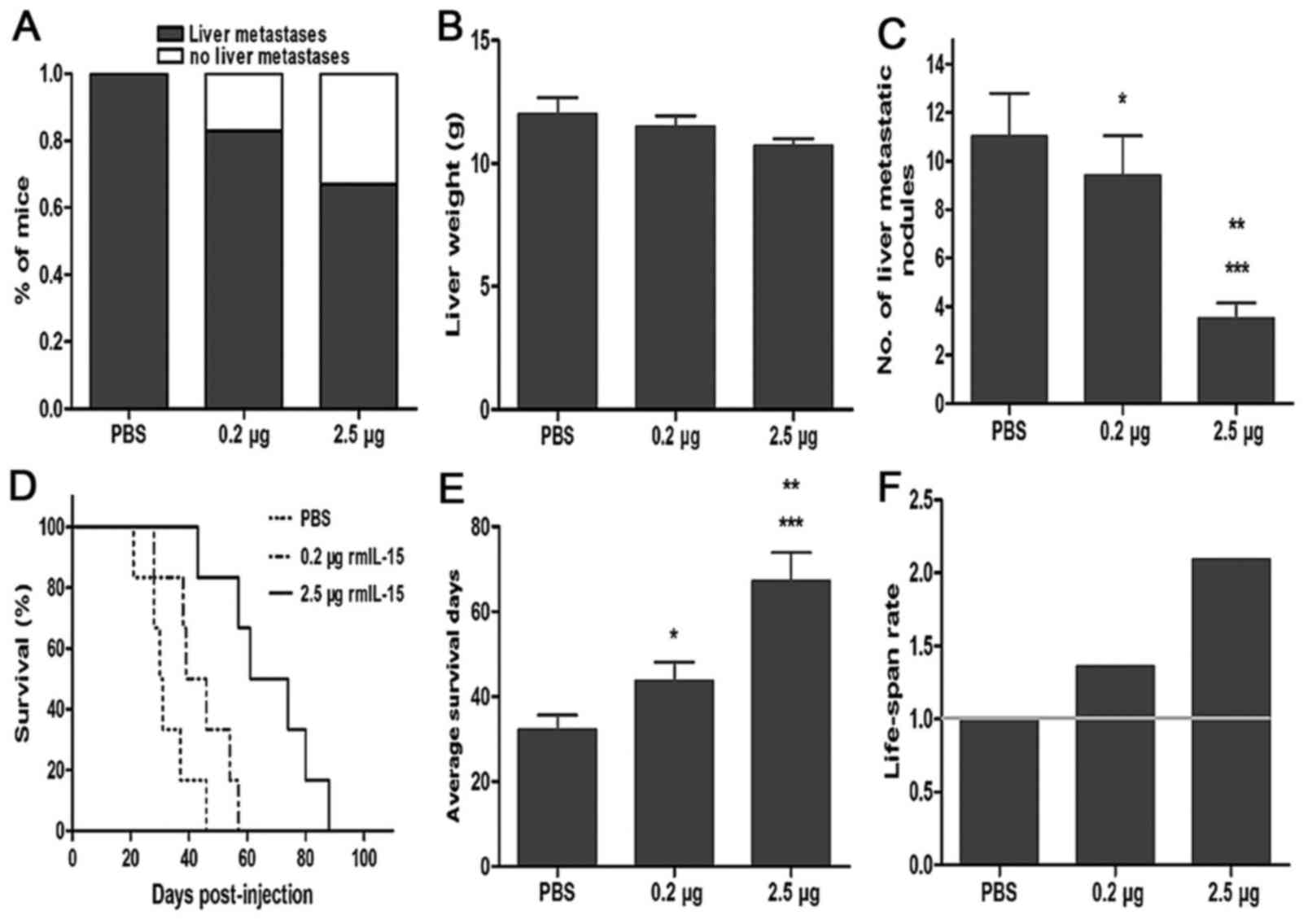 | Figure 3.Liver metastasis and survival of nude
mice. Mice were inoculated with 1×106 MKN45 cells into
the spleen parenchyma. After 24 h, they were divided into three
groups: Control (PBS treatment), 0.2 µg rmIL-15 and 2.5 µg rmIL-15.
At day 28, metastasis nodules on the livers were counted. The rest
of the mice were monitored daily until mortality. (A) 66.7% (4/6)
and 83.3% (5/6) of mice given high or low dose rmIL-15 developed
liver metastases, respectively, in contrast to 100% (6/6) among
PBS-treated mice. (B) Mean liver weight of the three experimental
groups; no significant difference among three groups (P>0.05).
(C) rmIL-15 treatment caused a decrease in the number of liver
metastasis nodules compared with PBS treatment, (P<0.05), and
the number of liver metastasis nodules of the high dose rmIL-15
group was significantly less than the low dose group (P<0.05).
(D) Kaplan-Meier survival curves, (E) average survival and (F)
increased life-span rate in the liver metastasis model confirmed an
association between 2.5 µg rmIL-15 therapy and longer survival
time. Data are presented as the mean ± standard deviation. All
statistics were calculated by the long-rank test (*P>0.05 vs.
control, **P<0.05 vs. 0.2 µg, ***P<0.01 vs. control).
rmIL-15, recombinant mouse interleukin-15. |
IL-15 treatment increases the survival
rate of nude mice
In the survival assay, mice were monitored daily
until mortality occurred. The Kaplan-Meier survival curves showed
that the probability of survival was significantly higher for mice
treated with the high dose rmIL-15 therapy (P<0.01 vs. low dose;
P<0.005 vs. control; Fig. 3D).
Mice treated with PBS survived a median of 32 days (range, 21–46
days). Animals treated with low dose rmIL-15 did not show a
survival advantage over animals treated with PBS (median survival,
44 days; range, 28–57 days; P>0.05). Mice receiving high dose
rmIL-15 (median survival, 59 days; range, 43–88 days) demonstrated
a significant prolongation of survival when compared with the
PBS-treated group (Fig. 3E). Lifespan
rate was calculated as the ratio of treated/control group. High
dose rmIL-15 therapy led to an increased life-span rate of (109%),
whereas low dose rmIL-15 improved by only (36%) (Fig. 3F).
IL-15 treatment increases the
concentration of IFN-γ in the bloodstream
Blood samples were obtained from the tail vein of
mice on day 12. IL-15 and IFN-γ secretion was measured. Mice
treated with rmIL-15 demonstrated an increased IFN-γ secretion
compared with the PBS control group in nude mice as well as the
Balb/c mouse model (P<0.05; Fig.
4).
IL-15 induces NK cell proliferation
and lytic activity
The target cells used were YAC-1 and MKN45 in NK
cell assays The studies showed that treatment with either high dose
mIL-15 or low dose mIL-15 had greater therapeutic efficacy. NK
cells are involved in the antitumor action mediated by mIL-15 in
nude mice or Balb/c mice model. It was revealed that mIL-15
treatment induced NK cell proliferation (Fig. 5) and increased the cytotoxic activity
of NK cells (Fig. 6) in nude mice and
Balb/c mice.
Discussion
In 1889, Paget (20)
found that the organ distribution of metastases is not a matter of
chance and first noted that metastasis from specific tumor types
grew in select secondary organ sites. Paget suggested that
metastases develop only when the seed (certain tumor cells with
metastatic ability) and the soil (organs providing growth advantage
to the seeds) are compatible (20).
Paget's seed and soil hypothesis stated that cancer metastasis
requires permissive interactions between tumor cells and secondary
organ microenvironments. IL-15 is a pleiotropic cytokine sharing
structural homology and receptor components with IL-2 (21,22). IL-2
has been approved by the Food and Drug Administration for use in
the treatment of patients with metastatic renal cell carcinoma and
malignant melanoma (23,24). However, its toxicity at high doses as
well as its ability to promote activation-induced cell death and
expansion of T regulatory cells had limited its contemplated use in
cancer treatment (25). In the past,
the antitumor effect of IL-15 has been widely reported (26–28), and
it has been recognized as a more promising cytokine than IL-2, with
the potential for application in tumor therapy, since IL-15 is more
potent than IL-2 in tumor therapy with greater therapeutic index
(29).
In recent years, several studies have provided
evidence that IL-15 administration serves an important role in
tumor therapy (28,30). Zhang et al (31) found IL-15 combined with an anti-CD40
antibody provides enhanced therapeutic efficacy for murine models
of colon cancer, combination of mIL-15 with the anti-CD40 antibody
enhanced the cytotoxic activity of NK cells and increased the total
NK cell numbers. Yu et al (32) showed that IL-15 treatment resulted in
a significant prolongation of survival in a metastatic murine colon
carcinoma CT26 model. The data reported in their study showed
enhancement of immune responses leading to increased antitumor
activity.
Liver metastasis contributed to the major cause of
mortality in patients with gastric cancer at advanced stages
(3,6,33). To the
best of our knowledge, this is the first study to demonstrate the
role of IL-15 in LMGC. The present study has revealed that the
presence of IL-15 could prolong the survival time of nude mice and
prevent liver metastasis from gastric cancer. Furthermore, it was
found that IL-15 enhances the cell activity of NK cells in nude
mice or immunogenicity mice. Evidence exists that IL-15 serves a
key role in murine NK cell homeostasis: NK cells are absent in
IL-15 knockout (34) and IL-15Rα
knockout mice (35). NK cells develop
from CD34+ hematopoietic progenitors, first in the fetal
liver, then in bone marrow and lymph nodes under the effect of the
cytokine IL-15 (36). The liver may
have unique precursors for memory NK cells, which are
developmentally distinct from NK cells derived from bone marrow
(37).
The present study showed that changes in the immune
microenvironment of the liver can affect tumor metastasis and
antitumor properties. The antitumor effects of IL-15 observed in
the present study are likely underestimated, since the experimental
systems used here excluded the effect of T cells. IL-15 is also
important for NK cell activation as IFN-γ and Granzyme B expression
in NK cells is induced by IL-15, and deficient in the absence of
IL-15 (38,39). IL-15 activated NK cells through the
IL-15/IL-15Rα complex trans-presentation (40). For the soil, the mechanism of liver
metastasis from gastric cancer was investigated from the
perspective of the target organ immune microenvironment. Target
organ microenvironment, particularly the immune microenvironment,
performs an important role in tumor metastasis (41,42). The
immunotherapy of cancer has made significant strides in the past
few years due to improved understanding of the underlying
principles of tumor biology and immunology (43,44). NK
cells are critical innate effectors with direct killing and
regulatory roles, shown to be important antitumor effectors,
exhibiting direct cytotoxicity and more regulatory,
cytokine-mediated effects (45).
Presumably, at least some of the aforementioned mechanisms could be
responsible for the development of cytotoxic effectors against
tumor cells in mice treated with IL-15.
In conclusion, IL-15 was found to exhibit a
significant therapeutic effect on liver metastasis from gastric
cancer by enhancing NK cell activity in a murine model. The
findings of the present study provide the scientific basis, and it
is expected that administration of IL-15 for clinical treatment of
patients with gastric cancer liver metastasis will be seen in the
future.
Acknowledgements
Not applicable.
Funding
The present study was supported by the Natural
Science Foundation of China (grant no. 81272726), the Specialized
Research Fund for the Doctoral Program of Higher Education (grant
no. 20110071120097) and the Shanghai Municipal Health Bureau
Research Project (grant no. 20114174).
Availability of data and materials
All data that were generated or analyzed in this
study are included in this manuscript.
Authors' contributions
WW, HH and JJ conceived and designed the study. FD,
ZC and ZL conducted the experiments. XL and HC performed the
statistical analysis. YZ interpreted the statistical analysis, and
reviewed and approved the final version of the manuscript to be
published. All authors read and approved the manuscript.
Ethics approval and consent to
participate
These experiments were approved by the Shanghai
Medical Experimental Animal Care Commission.
Consent for publication
Not applicable.
Competing interests
The authors declare that they have no competing
interests.
References
|
1
|
Smith RA, Cokkinides V and Brawley OW:
Cancer screening in the United States, 2012: A review of current
American Cancer Society guidelines and current issues in cancer
screening. CA Cancer J Clin. 62:129–142. 2012. View Article : Google Scholar : PubMed/NCBI
|
|
2
|
Sasako M, Sakuramoto S, Katai H, Kinoshita
T, Furukawa H, Yamaguchi T, Nashimoto A, Fujii M, Nakajima T and
Ohashi Y: Five-year outcomes of a randomized phase III trial
comparing adjuvant chemotherapy with S-1 versus surgery alone in
stage II or III gastric cancer. J Clin Oncol. 29:4387–4393. 2011.
View Article : Google Scholar : PubMed/NCBI
|
|
3
|
Sakamoto Y, Ohyama S, Yamamoto J, Yamada
K, Seki M, Ohta K, Kokudo N, Yamaguchi T, Muto T and Makuuchi M:
Surgical resection of liver metastases of gastric cancer: An
analysis of a 17-year experience with 22 patients. Surgery.
133:507–511. 2003. View Article : Google Scholar : PubMed/NCBI
|
|
4
|
Okuyama K, Isono K, Juan IK, Onoda S,
Ochiai T, Yamamoto Y, Koide Y and Satoh H: Evaluation of treatment
for gastric cancer with liver metastasis. Cancer. 55:2498–2505.
1985. View Article : Google Scholar : PubMed/NCBI
|
|
5
|
D'Angelica M, Gonen M, Brennan MF,
Turnbull AD, Bains M and Karpeh MS: Patterns of initial recurrence
in completely resected gastric adenocarcinoma. Ann Surg.
240:808–816. 2004. View Article : Google Scholar : PubMed/NCBI
|
|
6
|
Sakamoto Y, Sano T, Shimada K, Esaki M,
Saka M, Fukagawa T, Katai H, Kosuge T and Sasako M: Favorable
indications for hepatectomy in patients with liver metastasis from
gastric cancer. J Surg Oncol. 95:534–539. 2007. View Article : Google Scholar : PubMed/NCBI
|
|
7
|
Kakeji Y, Morita M and Maehara Y:
Strategies for treating liver metastasis from gastric cancer. Surg
Today. 40:287–294. 2010. View Article : Google Scholar : PubMed/NCBI
|
|
8
|
Burton JD, Bamford RN, Peters C, Grant AJ,
Kurys G, Goldman CK, Brennan J, Roessler E and Waldmann TA: A
lymphokine, provisionally designated interleukin T and produced by
a human adult T-cell leukemia line, stimulates T-cell proliferation
and the induction of lymphokine activated killer cells. Proc Natl
Acad Sci USA. 91:4935–4939. 1994. View Article : Google Scholar : PubMed/NCBI
|
|
9
|
Grabstein KH, Eisenman J, Shanebeck K,
Rauch C, Srinivasan S, Fung V, Beers C, Richardson J, Schoenborn
MA, Ahdieh M, et al: Cloning of a T cell growth factor that
interacts with the beta chain of the interleukin-2 receptor.
Science. 264:965–968. 1994. View Article : Google Scholar : PubMed/NCBI
|
|
10
|
Perera LP: Interleukin 15: Its role in
inflammation and immunity. Arch Immunol Ther Exp (Warsz).
48:457–464. 2000.PubMed/NCBI
|
|
11
|
Di Sabatino A, Calarota SA, Vidali F,
Macdonald TT and Corazza GR: Role of IL-15 in immune-mediated
andinfectious diseases. Cytokine Growth Factor Rev. 22:19–33. 2011.
View Article : Google Scholar : PubMed/NCBI
|
|
12
|
Armitage RJ, Macduff BM, Eisenman J,
Paxton R and Grabstein KH: IL-15 has stimulatory activityfor the
induction of B cell proliferation and differentiation. J Immunol.
154:483–490. 1995.PubMed/NCBI
|
|
13
|
Carson WE, Fehniger TA, Haldar S, Eckhert
K, Lindemann MJ, Lai CF, Croce CM, Baumann H and Caligiuri MA:
Apotential role for interleukin-15 in the regulation of human
natural killer cell survival. J Clin Invest. 99:937–943. 1997.
View Article : Google Scholar : PubMed/NCBI
|
|
14
|
Di Santo JP, Kuhn R and Muller W: Common
cytokine receptor chain (c)-dependent cytokines: Understanding in
vivo functions by gene targeting. Immunol Rev. 148:19–34. 1995.
View Article : Google Scholar : PubMed/NCBI
|
|
15
|
Asao H, Okuyama C, Kumaki S, Ishii N,
Tsuchiya S, Foster D and Sugamura K: Cutting edge: The common
-chain is an indispensable subunit of the IL-21 receptor complex. J
Immunol. 167:1–5. 2001. View Article : Google Scholar : PubMed/NCBI
|
|
16
|
Davies E, Reid S, Medina MF, Lichty B and
Ashkar AA: IL-15 has innate anti-tumor activity independent of NK
and CD8 T cells. J Leukoc Biol. 88:529–536. 2010. View Article : Google Scholar : PubMed/NCBI
|
|
17
|
Oh S, Berzofsky JA, Burke DS, Waldmann TA
and Perera LP: Coadministration of HIV vaccine vectors with
vaccinia viruses expressing IL-15 but not IL-2 induces long-lasting
cellular immunity. Proc Natl Acad Sci USA. 100:3392–3397. 2003.
View Article : Google Scholar : PubMed/NCBI
|
|
18
|
Munger W, DeJoy SQ, Jeyaseelan R Sr,
Torley LW, Grabstein KH, Eisenmann J, Paxton R, Cox T, Wick MM and
Kerwar SS: Studies evaluating the antitumor activity and toxicity
of interleukin-15, a new T cell growth factor: Comparison with
interleukin-2. Cell Immunol. 165:289–293. 1995. View Article : Google Scholar : PubMed/NCBI
|
|
19
|
Steel JC, Waldmann TA and Morris JC:
Interleukin-15 biology and its therapeutic implications in cancer.
Trends Pharmacol Sci. 33:35–41. 2012. View Article : Google Scholar : PubMed/NCBI
|
|
20
|
Paget S: The distribution of secondary
growths in cancer of the breast. Cancer Metastasis Rev. 8:98–101.
1889.
|
|
21
|
Giri JG, Ahdieh M, Eisenman J, Shanebeck
K, Grabstein K, Kumaki S, Namen A, Park LS, Cosman D and Anderson
D: Utilization of the beta and gamma chains of the IL-2 receptor by
the novel cytokine IL-15. EMBO J. 13:2822–2830. 1994. View Article : Google Scholar : PubMed/NCBI
|
|
22
|
D¨obbeling U, Dummer R, Laine E, Potoczna
N, Qin JZ and Burg G: Interleukin-15 is an autocrine/paracrine
viability factor for cutaneous T-cell lymphoma cells. Blood.
92:252–258. 1998.PubMed/NCBI
|
|
23
|
Heemskerk B, Liu K, Dudley ME, Johnson LA,
Kaiser A, Downey S, Zheng Z, Shelton TE, Matsuda K, Robbins PF, et
al: Adoptive cell therapy for patients with melanoma, using
tumor-infiltrating lymphocytes genetically engineered to secrete
interleukin-2. Hum Gene Ther. 19:496–510. 2008. View Article : Google Scholar : PubMed/NCBI
|
|
24
|
Klapper JA, Downey SG, Smith FO, Yang JC,
Hughes MS, Kammula US, Sherry RM, Royal RE, Steinberg SM and
Rosenberg S: High-dose interleukin-2 for the treatment of
metastatic renal cell carcinoma: A retrospective analysis of
response and survival in patients treated in the surgery branch at
the National Cancer Institute between 1986 and 2006. Cancer.
113:293–301. 2008. View Article : Google Scholar : PubMed/NCBI
|
|
25
|
Schwartz RN, Stover L and Dutcher J:
Managing toxicities of high-dose interleukin-2. Oncology (Williston
Park). 16 11 Suppl 13:S11–S20. 2002.
|
|
26
|
Sheng YQ, Cui LX, He W, Xue L and Ba DN:
Antitumor effects of human IL-15 gene modified lung cancer cell
line. Chin J Cancer Res. 9:240–244. 1997. View Article : Google Scholar
|
|
27
|
Xia H, Luo LM, Wen JX and Tong WC:
Inhibitory effects of recombinant human endostatin on growth and
metastasis of lung adenocarcinoma LA795 in mice. Ai Zheng.
21:1197–1202. 2002.(In Chinese). PubMed/NCBI
|
|
28
|
Lasek W, Basak G, Switaj T, Jakubowska AB,
Wysocki PJ, Mackiewicz A, Drela N, Jalili A, Kamiński R, Kozar K
and Jakóbisiak M: Complete tumor regressions induced by vaccination
with IL-12 gene-transduced tumor cells in combination with IL-15 in
a melanoma model in mice. Cancer Immunol Immunother. 53:363–372.
2004. View Article : Google Scholar : PubMed/NCBI
|
|
29
|
Sabbagh L, Snell LM and Watts TH: TNF
family ligands define niches for T cell memory. Trends Immunol.
28:333–339. 2007. View Article : Google Scholar : PubMed/NCBI
|
|
30
|
Chapoval AI, Fuller JA, Kremlev SG, Kamdar
SJ and Evans R: Combination chemotherapy and IL-15 administration
induce permanent tumor regression in a mouse lung tumor model: NK
and T cell-mediated effects antagonized by B cells. J Immunol.
161:6977–6984. 1998.PubMed/NCBI
|
|
31
|
Zhang M, Yao Z, Dubois S, Ju W, Müller JR
and Waldmann TA: Waldmann: Interleukin-15 combined with an
anti-CD40 antibody provides enhanced therapeutic efficacy for
murine models of colon cancer. Proc Natl Acad Sci USA.
106:7513–7518. 2009. View Article : Google Scholar : PubMed/NCBI
|
|
32
|
Yu P, Steel JC, Zhang M, Morris JC and
Waldmann TA: Simultaneous blockade of multiple immune system
inhibitory checkpoints enhances antitumor activity mediated by
interleukin-15 in a murine metastatic colon carcinoma model. Clin
Cancer Res. 16:6019–6028. 2010. View Article : Google Scholar : PubMed/NCBI
|
|
33
|
Okano K, Maeba T, Ishimura K, Karasawa Y,
Goda F, Wakabayashi H, Usuki H and Maeta H: Hepatic resection for
metastatic tumors from gastric cancer. Ann Surg. 235:86–91. 2002.
View Article : Google Scholar : PubMed/NCBI
|
|
34
|
Kennedy MK, Glaccum M, Brown SN, Butz EA,
Viney JL, Embers M, Matsuki N, Charrier K, Sedger L, Willis CR, et
al: Reversible defects in natural killer and memory CD8 T cell
lineages in interleukin 15-deficient mice. J Exp Med. 191:771–780.
2000. View Article : Google Scholar : PubMed/NCBI
|
|
35
|
Lodolce JP, Boone DL, Chai S, Swain RE,
Dassopoulos T, Trettin S and Ma A: IL-15 receptor maintains
lymphoid homeostasis by supporting lymphocyte homing and
proliferation. Immunity. 9:669–676. 1998. View Article : Google Scholar : PubMed/NCBI
|
|
36
|
Becknell B and Caligiuri MA:
Interleukin-2, interleukin-15, and their roles in human natural
killer cells. Adv Immunol. 86:209–239. 2005. View Article : Google Scholar : PubMed/NCBI
|
|
37
|
Jiang X, Chen Y, Peng H and Tian Z: Memory
NK cells: Why do they reside in the liver? Cell Mol Immunol.
10:196–201. 2013. View Article : Google Scholar : PubMed/NCBI
|
|
38
|
Minagawa M, Watanabe H, Miyaji C, Tomiyama
K, Shimura H, Ito A, Ito M, Domen J, Weissman IL and Kawai K:
Enforced expression of Bcl-2 restores the number of NK cells, but
does not rescue the impaired development of NKTcells or
intraepithelial lymphocytes, in IL-2/IL-15 receptor
beta-chain-deficient mice. J Immunol. 169:4153–4160. 2002.
View Article : Google Scholar : PubMed/NCBI
|
|
39
|
Koka R, Burkett P, Chien M, Chai S, Boone
DL and Ma A: Cutting edge: Murine dendritic cells require
IL-15Ralpha to prime NK cells. J Immunol. 173:3594–3598. 2004.
View Article : Google Scholar : PubMed/NCBI
|
|
40
|
Castillo EF and Schluns KS: Regulating the
Immune system via IL-15 Transpresentation. Cytokine. 59:479–490.
2012. View Article : Google Scholar : PubMed/NCBI
|
|
41
|
Budhu A, Forgues M, Ye QH, Jia HL, He P,
Zanetti KA, Kammula US, Chen Y, Qin LX, Tang ZY and Wang XW:
Prediction of venous metastases, recurrence, and prognosis in
hepatocellular carcinoma based on a unique immune response
signature of the liver microenvironment. Cancer Cell. 10:99–111.
2006. View Article : Google Scholar : PubMed/NCBI
|
|
42
|
Muller AJ and Scherle PA: Targeting the
mechanisms of tumoral immune tolerance with small-molecule
inhibitors. Nat Rev Cancer. 6:613–625. 2006. View Article : Google Scholar : PubMed/NCBI
|
|
43
|
Hammerstrom AE, Cauley DH, Atkinson BJ and
Sharma P: Cancer immunotherapy: Sipuleucel-T and beyond.
Pharmacotherapy. 31:813–828. 2011. View Article : Google Scholar : PubMed/NCBI
|
|
44
|
Cheson BD and Leonard JP: Monoclonal
antibody therapy for B-cell non-Hodgkin 7S lymphoma. N Engl J Med.
359:613–626. 2008. View Article : Google Scholar : PubMed/NCBI
|
|
45
|
Ljunggren HG and Malmberg KJ: Prospects
for the use of NK cells in immunotherapy of human cancer. Nat Rev
Immunol. 7:329–339. 2007. View Article : Google Scholar : PubMed/NCBI
|















